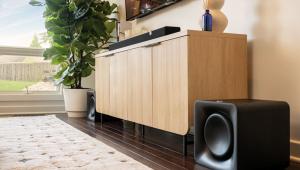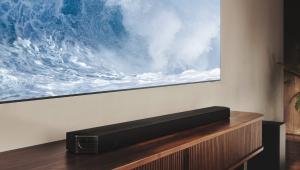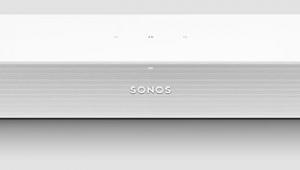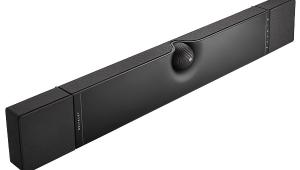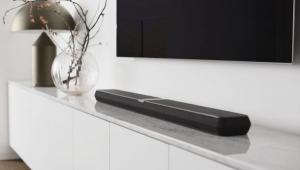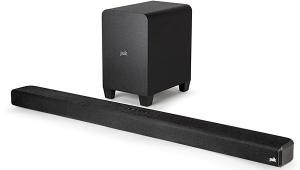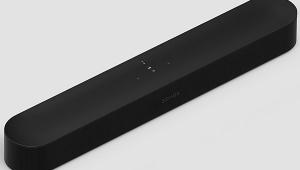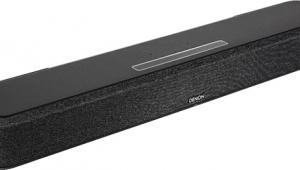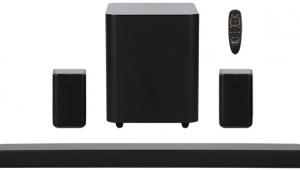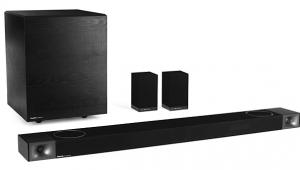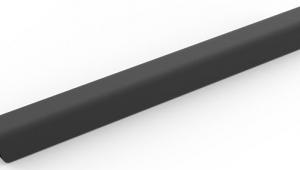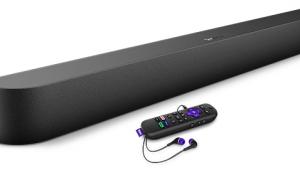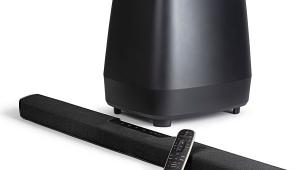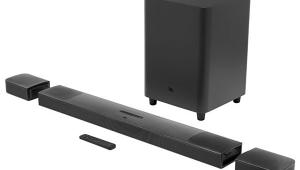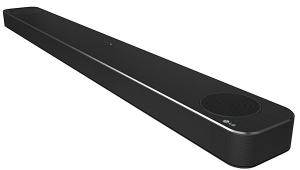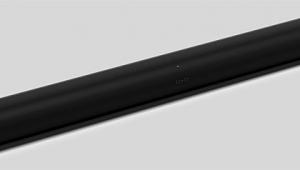Bluesound Pulse Soundbar and Pulse Sub Review Page 2
Bar Bass
For me, adding the Pulse Sub was merely a matter of plugging it into AC power; in a few moments, the soundbar found the sub and paired automatically. The subwoofer itself is a delightfully compact package, just about the size, shape, and weight of a well-stuffed lawyer’s briefcase (the case being well stuffed, not the lawyer). It’s cleverly designed for mounting on a wall (via a supplied, slide-on bracket) or placing on the floor, vertically or horizontally. I experimented a good deal with location, which I found quite influential, and I ultimately settled on tight against the wall a few feet to the right of my screen. The sub has a full control panel concealed behind an oblong rubber plug, with level, crossover, and phase knobs, plus an auto-power mode toggle switch. Bluesound’s nominal default for the Crossover setting is 130 Hz with Volume at the 12 o’clock position (the bar itself is said to roll off at around 90 Hz when paired with the sub), but I found my preferred settings to be slightly lower in both cases.

The Pulse Sub effected surprisingly little change on the soundbar’s general character. Overall, bass emphasis and tonality remained virtually unaltered, and ultimate level gained only slightly. What the sub did contribute was an extra octave-plus of real bass, extending—extraordinarily for so tiny a subwoofer—right down to what sounded like a legitimate 30 Hz and even a touch lower. Obviously, so small a sub can’t contribute a huge amount of deep bass. But at moderate listening levels, it added real bottom-octaves foundation without sacrificing bass tonality or definition in any substantial degree. This was readily apparent on bass classics like the T. Rex footsteps from Jurassic Park, which, though impressively solid on the Pulse Soundbar alone, were much more ominous with the Pulse Sub engaged. The subwoofer’s presence was just as welcome on full-range music. At moderate levels, my dubstep torture tracks sounded shockingly “infra,” while familiar fare like Pink Floyd’s “Speak to Me” (the heartbeats) from The Dark Side of the Moon revealed the underpinnings that had been absent without the sub.

Bar Ware
The Bluesound app delivers a generous set of audio adjustments for the Pulse Soundbar on its Player page, beginning with three primary listening modes: TV, Music, and Movie. These appeared to effect change by managing equalization, dynamics-processing, and to some degree, stereo presentation. In listening comparisons, I found that the TV mode sounded a bit narrower/tighter/brighter, Movie was wider/brighter/punchier, and Music, as best I could judge, left things more or less untouched. Neither TV nor Movie produced overt processing artifacts: voices remained natural, and ambient cues likewise were non-phasey and un-clangorous.
As for surround sound with multichannel, there presently is none (though, as noted, Bluesound is said to be working on updates that would allow connection of their standalone wireless speakers as rear channels). Unlike some other two-channel soundbars, the Pulse—wisely, in my view—makes no attempt at faux surround via digital signal processing. (In my experience, these can sometimes be productive but never truly rival the real, multi-speaker thing.) Bluesound instead offers a Wide Mode, with Off/Wide/Wider options. This operated to highly variable effect depending on the program material, being most noticeable on natural-stereo music and certain sorts of filmsound, usually highly ambient scenes. Though no specific information is available on the technique employed here, many of these “spreader” schemes manipulate the balance of the mono (left+right) and stereo-difference (left-minus-right, plus right-minus-left) components of the two channels, along with some judicious EQ.
In either position, I found the setting not so much to “widen” the soundstage as to “deepen” it, by raising the balance of ambient cues contained in the “difference” component of stereo recordings. I rarely found Wider to be an improvement (it seemed to noticeably brighten, and to a smaller extent, harshen dense textures) over Wide, which in some cases I favored for both music and movie sound. Mostly, though, the “Wide Mode: Off” setting got my nod for naturalness. Thus unprocessed, on the best natural-acoustic recordings, the Pulse’s soundstage could extend impressively close to its physical left and right ends, with a pleasing degree of depth and razor-sharp lateral location, within its width, of instruments and voices.
Among other adjustments, the BlueOS app also offers ±6 dB bass and treble controls, as well as a Late Night mode, which worked about as you’d expect, limiting peak levels and normalizing overall dynamics. I found that at most master-volume settings, including fairly high ones, engaging Late Night had the consequence of raising the overall subjective volume substantially, requiring manual lowering of the master volume slider by perhaps 6 dB to maintain parity. Pairing the Pulse Sub also adds a ±6 dB Subwoofer Level trim slider and a Boost button that yields a relatively subtle bass goosing but also seemed to engage sub limiting to prevent overload. The last sub addition is a Subwoofer Delay slider (20 ms max), offered for improving sub integration in some setups.
Kind of Blu
Beyond this, I found that when I connected and played music from my iOS phone to the Pulse Soundbar via Bluetooth, the two volume controls—on BluOS and the phone’s Music app—were not rationalized. So, adjusting one using the phone’s hardware buttons would elicit response from both, causing unexpectedly fast volume changes. Worse, getting full or close-to-full volume required manually adjusting both volumes sequentially, via onscreen click-drags—not really ideal. (Maxing the phone’s volume, and using only the BlueOS onscreen volume slider was Bluesound’s recommended solution.) To be fair, this state of affairs obtains with plenty of other systems, like BT-ready A/V receivers, though some I’ve used have shown better volume-linking. (Incidentally, while the soundbar is capable of AptX Bluetooth, alas my source was not, so Bluetooth sound quality was no better than what I’d expected.)
<
Of course, as with any other software/firmware-based system, all of these factors are likely addressable. Bluesound pushed one set of upgrades during my review period, and more are undoubtedly in the works. Finally, though ultimately unrelated to performance, I’d be remiss not to call Bluesound out on its inadequate documentation. Getting simple instructions for executing the remote control IR learning or connecting a source by Bluetooth required sleuth-like poking around online or in the Bluesound app; neither was explained in the printed Quick Setup Guide or the “full” manual on Bluesound’s website, which I judged to be reticent to the point of secrecy. In broader terms, I sometimes felt quite keenly the lack of a general overview guide to BluOS software functionality and operations. Bluesound does provide a Resources link, though not prominently, on its Support web page, but this opens a somewhat scattershot series of articles and forum links. Most everything I searched for was findable, but a more coherent and organized source would have been very welcome.
Closing Time

BluOS software and multiroom systems have been covered in these pages already, and my experience here was generally consistent with my colleagues’. Which is to say, I found the software mostly intuitive and largely stable, but I did encounter a few things to gripe about. For example, I occasionally found issues with the app keeping up with my commands, made obvious in things like very slow onscreen volume-slider refresh, and also encountered seemingly glacial response when selecting hi-res recordings for play. However, when I reinstalled the bar for a second go-round a couple of weeks later, both these problems were utterly gone. No, I don’t have an explanation.

It hardly needs to be said: For TV and movie sound, the Pulse Soundbar provides an immeasurable upgrade over in-TV audio, with order-of-magnitude gains in range, dynamics, and tonal realism. When I casually watched news, sports, and the like, the Pulse quickly disappeared into the furniture—precisely what you want from a soundbar—by becoming part of the TV, just louder, deeper, and much, much better. When I watched movies, especially with the Pulse Sub paired and dialed in for a 2.1-channel system with its matching subwoofer, the Bluesound delivered a qualitative experience (less the top 10 dB of “show-demo” loudness and the surround dimension) that any home theater vet would approve of. And even the closest music listening, especially of well-recorded natural-acoustic fare, revealed sound quality that wouldn’t shame a serious audio system many times its size. If this isn’t a soundbar encomium, I don’t know what is.
- Log in or register to post comments
